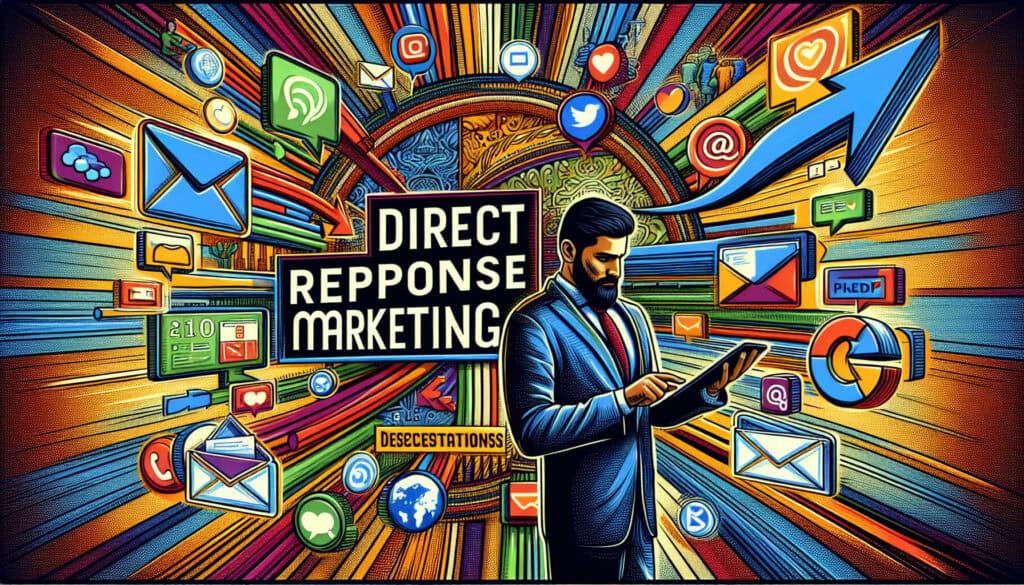Un tipo de marketing designed to elicit an instant response by encouraging prospects to take a specific action.
- Metodologías: Lean Sigma, Fabricación
Direct Response Marketing

Direct Response Marketing
- Pruebas A/B, Metodología ágil, Tasa de conversión, Experiencia del cliente, Marketing digital, Estrategia de comercialización, Propuesta de valor
Objetivo:
Cómo se utiliza:
- This strategy uses compelling calls-to-action (CTAs) like 'Call now,' 'Click here,' or 'Order today.' Its success is measured by the number of responses (e.g., clicks, calls, or sales) it generates.
Ventajas
- The results are highly measurable, making it easy to calculate ROI; can generate sales and leads quickly; is very data-driven.
Contras
- Can be perceived as aggressive or 'salesy'; often focuses on short-term conversions rather than long-term brand building.
Categorías:
- Clientes y marketing
Ideal para:
- Prompting an immediate, measurable action from a potential customer through a targeted advertisement.
Direct Response Marketing finds extensive application in industries such as e-commerce, financial services, and technology where immediate consumer interaction is paramount. Campaigns integrating this strategy are typically employed during product launches or promotional periods, with marketing teams spearheading initiatives crafted around specific demographics. Tools like email marketing, social media ads, and telemarketing often feature urgent CTAs that encourage direct consumer engagement. Participation from cross-functional teams—including sales, marketing, and customer service—is essential for creating cohesive messaging that resonates with target audiences. This methodology is particularly beneficial in lead generation strategies where metrics are closely monitored; sales teams can effectively track responses through various analytics tools, enabling them to make data-driven decisions quickly. For example, a tech company launching a new software might run a series of pay-per-click ads with strong CTAs that push viewers to download a demo, and the success of this campaign can be measured by download rates and follow-up calls. By aligning sales and marketing efforts, organizations can achieve a higher conversion rate, transforming inquiry into sales efficiently.
Pasos clave de esta metodología
- Define clear objectives and specific CTAs.
- Develop targeted messaging that resonates with the audience.
- Select appropriate channels for ad placement.
- Create compelling ad creatives that enhance the offer.
- Implement A/B testing for different variations of ads.
- Launch the marketing campaign across chosen channels.
- Monitor responses in real-time to gauge performance.
- Optimize campaigns based on real-time feedback and metrics.
- Scale successful campaigns for wider reach and impact.
- Utilize retargeting strategies to engage previous responders.
Consejos profesionales
- Utilize A/B testing extensively to refine CTAs based on real-time data, optimizing for language, placement, and design.
- Segment your audience meticulously to tailor messaging that resonates with various demographics, increasing response likelihood.
- Incorporate urgency into CTAs by leveraging time-sensitive offers, compelling potential customers to act swiftly.
Leer y comparar varias metodologías, recomendamos el
> Amplio repositorio de metodologías <
junto con otras más de 400 metodologías.
Sus comentarios sobre esta metodología o información adicional son bienvenidos en la dirección sección de comentarios ↓ , así como cualquier idea o enlace relacionado con la ingeniería.
Contexto histórico
1960
1980
1983
1990
1995
2000
2010
1950
1980
1980
1986
1994
1995
2000
(si se desconoce la fecha o no es relevante, por ejemplo "mecánica de fluidos", se ofrece una estimación redondeada de su notable aparición)














Publicaciones relacionadas
Gestión de operaciones de fabricación (MOM)
Sistema de Ejecución de Fabricación (MES)
Plan de control de la fabricación
Pruebas manuales
Tablas de evaluación de la manipulación manual (MAC)
ManTRA (Herramienta de evaluación de riesgos en las tareas manuales)